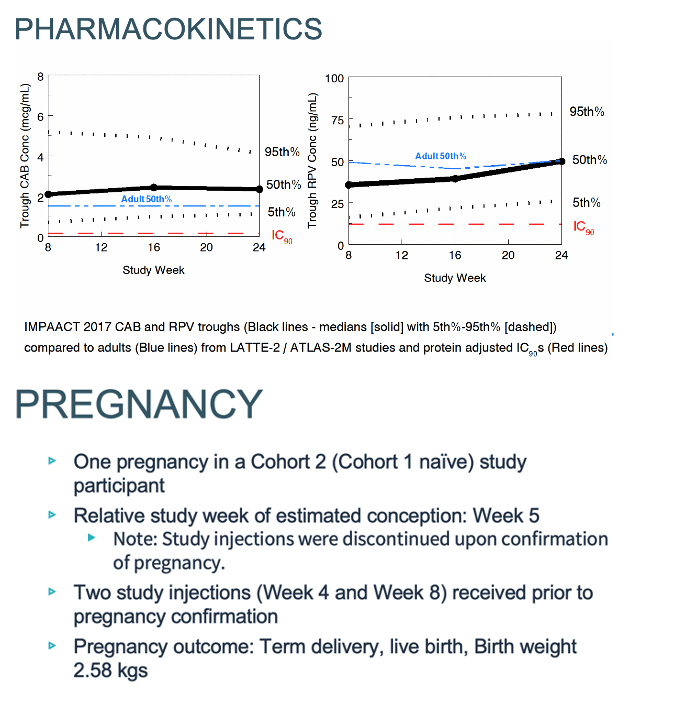 |
 |
 |
| |
No Virologic Failures, Good Safety With LA I
njected CAB + RPV for Adolescents IMPAACT 2017 MOCHA Study
|
| |
| |
CROI 2024 (Conference on Retroviruses and Opportunistic Infections), March 3-6, 2024, Denver
Mark Mascolini
Week-24 results from the IMPAACT 2017 (MOCHA) trial confirmed the safety and adult-equivalent trough concentrations of long-acting injected cabotegravir (CAB) plus rilpivirine (RPV) for adolescents with HIV infection [1]. Investigators have recorded no virologic failures of the every-2-month regimen in 144 participants treated so far.
IMPAACT 2017 is the first trial to treat adolescents with long-acting injected CAB + RPV after they attained an undetectable viral load with an oral antiretroviral combination [2]. US and other regulatory bodies have licensed CAB + RPV every 4 or 8 weeks in adults with antiretroviral-induced control of HIV.
The trial of CAB + RPV in youngsters enrolled adolescents from 12 to less than 18 years old and weighing at least 35 kg. They all swapped their all-pill combination for oral CAB and RPV for 4 weeks, then for 600 mg of CAB and 900 mg of RPV injected every 8 weeks. The first two sets of CAB + RPV injections were given 4 weeks apart and all subsequent injections 8 weeks apart.
This analysis involved Cohort 2 of IMPAACT 2017, which enrolled 144 participants in 5 countries: Botswana, South Africa, Thailand, Uganda, and the United States. Of those 144 participants, 142 completed week 4, the oral lead-in phase, all but 2 got at least 1 injection, 141 attended the week-24 visit, and 116 (80.5% of 144) completed the week-48 injection.
These 144 adolescents had a median age of 15 years (range 12 to 17), 51% were female, and 74% black or African American. Most participants, 92%, acquired HIV perinatally. Median body mass index stood at 19.5 kg/m2 and median weight at 48 kg.
Forty-nine participants (35% of 142) reported an injection site reaction, most of which (86%) resolved within 7 days. One participant had a study drug-related grade 3 injection site abscess and another had a study drug-related injection site abscess and grade 3 injection site pain. Neither dropped out of the trial. Injection site reactions affected almost half of study participants with the first injection. After that, 25% or fewer participants had an injection site reaction at any visit up to week 80.
Excluding injection site reactions, through 24 weeks of treatment 16 of 144 adolescents (11%) had a grade 3 or worse adverse event, including 6 increases in blood creatine phosphokinase and 3 upswings in systolic blood pressure. The researchers considered none of these adverse events related to study drugs. No one quit the study because of study drug-related toxicity, and no deaths or life-threatening events could be attributed to study drugs. Participants stated an "overwhelming preference for long-acting injections over oral medications."
All but 5 participants (3.5%) kept their viral load below 50 copies through week 24. No one had a confirmed virologic failure (2 consecutive viral loads at or above 200 copies). One participant became pregnant after her first two injections, and treatment stopped at that point. She had a live birth term delivery of an infant weighing 2.58 kg (5.7 lb).
Median week-24 predose concentrations of CAB (2.34 ug/mL, 1.11 to 4.15) and RPV (49.5 ng/mL, 25.9 to 78.1) were similar to concentrations in adults getting injected CAB + RPV in clinical trials.

|
| |
|
 |
 |
|
|